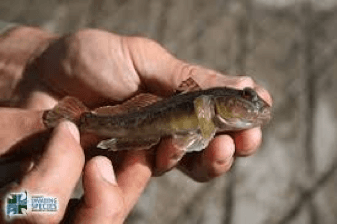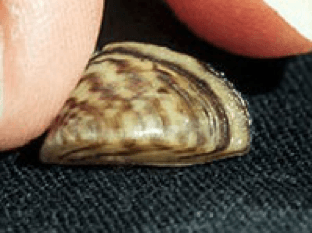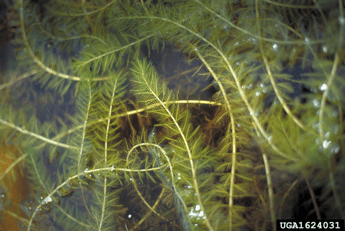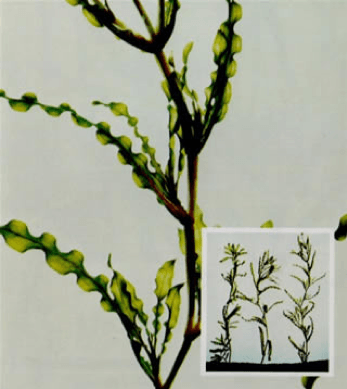
Aquatic Invasive Species
Key Facts
An invasive species is from a foreign geographical area and grows excessively, diminishing the number and habitat area for native species.
How does this threat impact you and Torch Lake?
- Interferes with swimming, boating and fishing
- Impacts growth rate and populations of fish
- Potential to harm boat propellers
- Potential to harm humans
- Costs a lot to manage and almost impossible to remove
- Decreases number of native species
Did You Know?
The following aquatic animals and plants are already in Torch Lake.
Invasive species in Torch Lake in 2023
Fish: Round Goby

Photo: David Copplesotne, Ontario’s Invading Species Awareness Program
Native: Black and Caspian Seas
Impact: Can impact fish populations, but appears to assimilate into food web as prey for larger fish
Invasive Features:
- Bottom Dwelling Fish up to 10 inches
- Eats Eggs and young of native fish like lake trout, competes with sculpin, eats zebra mussels
Means of Introduction: Recently, June 2018, found in Torch Lake also present in Grand Traverse Bay, Lake Charlevoix and Jordan River.
First found in North America in 1990 in St. Clair River between Lake Huron and Lake St. Clair.
Response: Round Goby recently identified in Torch Lake during DNR Fish Survey of 2018.
Crustacean: Rusty Crayfish

Photo: USGS
Native: Ohio, Kentucky and Indiana
Impact: Lowers native crayfish population, potential to impact fish populations
Invasive Features:
- More aggressive than native crayfish, avoids fish predation more than natives and eats eggs and young of native crayfish.
Means of Introduction: Into the Elk Rapids Chain of Lakes as bait release by anglers and/or aquarium release by hobbyists, teachers or students who enjoy or study the species.
Response: Population of Rusty Crayfish in Torch Lake has not been studied nor removal pursued.
Mollusk: Zebra Mussels

Photo: Amy Benson, USGS
Native: Black, Caspian and Azov Seas
Impact: Lowers native clam population, changes in food web, including stimulating bottom algae growth, deep cuts to humans, clogs pipes.
Invasive Features:
- Deprives food (plankton floating in water) to native clams and young fish.
- Very sharp shells cause deep cuts to humans, clogs water pipes.
Means of Introduction: In 1990s by ballast water from transoceanic ships into the Great Lakes. By late 1990s and early 2000s Zebra mussels, their larvae or eggs attached to recreational boats in the Great Lakes were launched into inland lakes in the Elk River Chain of Lakes.
Response: Zebra Mussel population was not studied in Torch Lake. But, following a peak in their population one summer, numbers crashed due to lack of food.
Mollusk: Quagga Mussels

Native: Black and Caspian Seas
Impact: Changes food web including stimulating bottom algae growth. Clogs intake pipes. Lowers zebra mussel population.
Invasive Features:
- Deprives food to plant eating fish by consuming algae-plankton in the water. Eats fish larvae, fingerlings and small fish.
Means of Introduction: In 2000 by ballast water from transoceanic ships into the Great Lakes; Recreational boats in Great Lakes launched into inland lakes in the Elk River Chain of Lakes (Elk and Torch Lakes) carried mussel larvae and eggs.
Response: Quagga mussels were initially found in Torch lake in 2015. Three Lakes Association confirmed their presence in Torch Lake’s deep water in 2023.
Aquatic Plant: Eurasian Watermilfoil

Photo: Alison Fox, University of Florida
Native: Europe, Asia and N. Africa
Impact: Shades out native aquatic plants, decreasing numbers of native aquatic plants and other aquatic creatures, interferes with recreation activities, not a food source for waterfowl, interferes with fish predation, clogs water pipes
Invasive Features:
- Grows from fragments of the plant and underground runners.
Means of Introduction: Introduced as an ornamental plant in 1940s. Reached Midwest in 1980.Currently found in 45 of the 50 United States.
Response: Three Lakes Association has been active in monitoring and removing Eurasian Milfoil from Alden Harbor, Torch Lake embayment south of Clam River and in Clam River at Butch’s Boat Launch since 2000. Benthic barriers, hand pulling with snuba and chemical application methods have been used. Eurasian milfoil continues to return.
Found in: Torch Lake
- Clam River Outlet at Butch’s Marina Launch and Boatwells
- Immediately South of Clam River Outlet In Stoney Point Embayment
- Off Alden at the Old School Boiler
- Alden Safe Harbor and Boatwells
- Sandbar Sucker Holes
Show
You Care
We know you want to enjoy the lake for many years (and generations) to come. So, we’ve put together a list of simple steps you can take to reduce the nutrients, sediments and toxins flowing into the lake and its streams.
Prevent invasive species from entering Torch Lake from your boat trailer, your boats, jet skis, canoes, kayaks, paddleboards and fishing gear.
Some invasive species you can see but others are microscopic and can cling to hulls and equipment.
Anyone fishing with live or cut bait or practicing catch-and-release fishing will need to take precautions to limit the movement of invasive species and fish diseases.
Boating Law Effective 2019
Beginning March 21, 2019, watercraft users in the state are required to take steps to prevent the spread of aquatic invasive species.
Step 1.Whenever you exit or enter a new body of water
- Clean off plants from boats, trailers and equipment.
- Drain water from live wells, bilges and ballast tanks.
- Dry off boats and equipment.
- Dispose of any plants and unwanted bait in the trash.
Step 2. Carefully clean your fishing gear after each use.
With these simple habits after getting out on the water, we can keep the following invasive species out of Torch Lake.
Aquatic Invasive Species in the Region
Let’s Keep Them Out of Torch Lake
If you suspect you see one of these aquatic invasive species in Torch Lake, please contact Michigan Invasive Species Program by email at [email protected] OR contact Antrim Counservation District at 231-533-8363 or [email protected].
Invasive: Mollusks
New Zealand Mud Snails

Photo: Utah Division of Wildlife Resource
Locations:
- Shanty Creek flowing into Grass River
- Boardman and Au Sable Rivers
Characteristics:
Native to New Zealand.
Found in Snake River Idaho in 1987, now in 10 western states and 4 of the 5 Great Lakes (not Huron)
Very small, 1/8th inch snails lives in streams, rivers and lakes in mud, rocks, aquatic vegetation and woody debris.
Reproduces without fertilization. Female lays up to 120 eggs at a time.
Can survive out of water for several weeks in cool, damp conditions.
Travels in fishing gear.
Impact-Fish Populations
Invasive: Plants
Curly Pondweed

Photo: USGS-Great Lake Science Center
Locations:
- Intermediate River in Bellaire
- Torch River and the Bayou
- Cedar and Rapid Rivers
- Lake Charlevoix and Crooked Lake near Petoskey
Characteristics:
Native of Eurasia, Africa and Australia
Introduced in mid 1800s to the United States
Forms dense mats like Eurasian Watermilfoil
Impact- interferes with recreational activities and inhibits growth of native plants
Starry Stonewort

Locations:
- Horseshoe Lake south of Waters in Crawford County
- Houghton Lake
- Numerous lakes in southern Michigan
- 4 of 5 Great Lakes (not Superior)
Characteristics:
Native to Europe, Asia and Japan
In 1978 introduced in ballast water along St. Lawrence River, 1981 Lake Ontario, 1983 Lake St. Clair. Michigan has most reported occurrences of any state.
Forms dense mats in lakes.
Impacts- interferes with recreational activities, fish movement and spawning.
Hydrilla

Photo: SC DNR
Locations:
- 2 Southwest Michigan private ponds
- Ohio
- Indiana
Characteristics:
Native to India and Sri Lanka.
Introduced in 1950s by aquarium trade. Entered Florida water system and currently in 28 Southeast and Western States.
Grows from fragments and tubers.
Impacts – Interferes with recreational activities and inhibits growth of native plants
WATERpedia: the “One-Stop Shop” for Water Science A-Z
A-E
F-M
N-S
T-Z
Don't just wish that Torch Lake will stay blue.
Choose a water-friendly lifestyle - make a difference!
About
Social
Subscribe to TRUE BLUE News
Follow us on Facebook
Share a favorite photo with us on Instagram (#truebluetorch)
